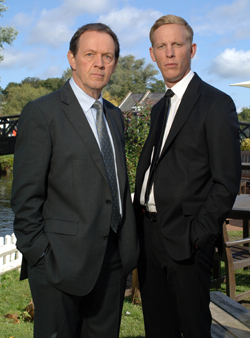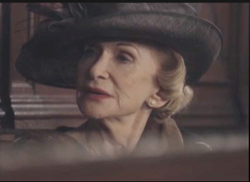
How generous of him to provide the basis, the title, and the hidden message for this week’s installment of Inspector Lewis on Masterpiece Mystery.
“Wild Justice” is all about revenge—bitter, poetic revenge. None of that prosaic eye-for-an-eye stuff. We’re talking about desire for revenge that simmers until it can’t be contained any longer and you just have to bury someone up to the waist in dirt, starve him to death, and tack an explanatory note—in Italian no less—to his chest.
Can’t imagine such a thing? Then you haven’t spent enough time in Oxford with Inspector Lewis.
Sure, Lewis sees plenty of people who have been whacked over the head, shot, stabbed, or strangled to hasten them on their way to the hereafter. But he encounters just as many who are killed by methods derived from obscure literary works and whose corpses are accompanied by cryptic clues written in perfect calligraphic script.
There’s nothing quite as sinister as murder committed within a religious community. In this case the community is St. Gerard’s Hall. With a history dating back to the 13th century, as Lewis’s partner Sergeant Hathaway helpfully reminds us, St. Gerard’s is now a privately funded enclave that is affiliated with the University of Oxford.
As is often the case, the character we follow for the first five minutes of the program is dead by minute six. This time it’s Helen Parsons, an Anglican bishop from, of all places, Portland, Oregon.
Yes, that’s right. A bishop named Helen.
If that surprises you, you’re not alone. There are plenty of characters in this episode who find the idea of a female bishop unsettling. But that’s not the only thing unsettling here. This time out, the players have particularly murky backgrounds. The murders (there are four, because Inspector Lewis always gives good value) are rather gruesome. And most unsettling of all, we’re receiving strong hints that Hathaway is rethinking his career choice and Lewis is considering early retirement!

Lewis is interested in Italy, too. He’s planning a vacation there, and his conversations about it include an allusion to an Inspector Morse episode from twenty-odd years ago.
The faithful will be gratified.
In fact, “Wild Justice” is the sort of Inspector Lewis episode that reminds us how well a spin-off can complement the original and gratify the faithful. It’s not just any TV series that can weave 17th-century Jacobean revenge drama into a contemporary police procedural. Lewis gives us deaths direct from The White Devil by John Webster, The Changeling by Thomas Middleton and William Rowley, The Atheist’s Tragedy by Cyril Tourneur, and Shakespeare’s Titus Andronicus. (Yes, picky person, Titus Andronicus is Elizabethan. Now stop reading blogs and go finish writing your dissertation.)
The Devil’s Friar by “Fulworth” also figures in this episode. Better researchers than I have tried and failed to find another reference to that particular work, leading to speculation that screenwriter Stephen Churchett made it up.
The clearest indication that it’s not real is the fact that Sergeant Hathaway doesn’t chime in immediately with an explanation about the history and significance of the text as soon as it’s mentioned. If The Devil’s Friar were an actual work Hathaway would know it. Let’s face it, there’s not much Hathaway doesn’t know.
In this episode he’s particularly adept with names and dates. Firing off quotes from John Webster at will, he strains belief. Then, about an hour and two minutes in, he redeems himself with a line about misplaced apostrophes that will warm the hearts of frustrated copy editors everywhere.
You can understand why Lewis appreciates him. Their relationship has a warmth that Lewis never quite managed with Morse. But how long can it last? Would Lewis really take early retirement and leave Hathaway on his own? Would Hathaway really give up policing for the academic life?
Questions linger. Then again, “A prudent question is one-half of wisdom.” Hathaway could tell you Francis Bacon wrote that.
Watch “Wild Justice” on the PBS website.
Leslie Gilbert Elman blogs intermittently at My Life in Laundry. She’s written two trivia books and has a few unpublished fiction manuscripts in the closet to keep the skeletons company.

I love this show, as I loved Inspector Morse. Hathaway’s character is a gem–the bright spot in almost every episode, illuminating and warming Lewis’ dour demeanor to the point where I no longer feel that he’s about to succumb to clinical depression.
I haven’t yet read that there is another series coming, but I have my fingers crossed!
I love it.
I’m with you 100 percent. I love that the writers have given Hathaway depth that makes him much more than a smartypants, and the relationship between the two characters has humor that Lewis and Morse rarely had.
Now, at the risk of revealing a spoiler…
It’s safe to uncross your fingers.
Really very happy to say,your post is very interesting to read.I never stop myself to say something about it.You’re doing a great job.Keep it up